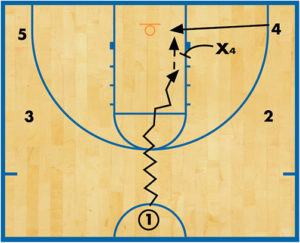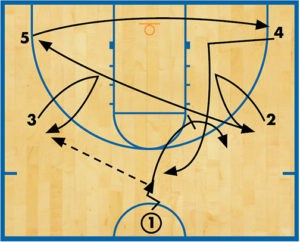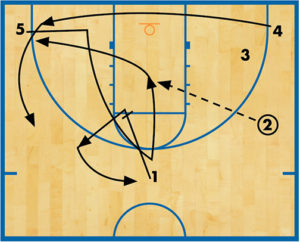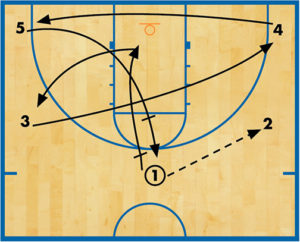Five-out spread continuity counters aggressive man defense
This five-out spread continuity offense can be utilized in a variety of situations. We have implemented this offense to counter aggressive man-to-man defense, use some clock when holding the lead, provide our best player some freedom to create off dribble penetration and, of course, as a primary offense.
The offense works best if four out of the five players are strong with the ball and can be considered above average passers. If you have a player who is not necessarily the best passer or decision make, this offense also provides an opportunity to “hide” a player of this caliber.
The offense begins with our point guard (1) handling the ball just over midcourt, our 2 and 3 players are at the old hash marks, and our post players begin in each corner. The point, or any player handling the ball at the top of the key, has the freedom to attack the basket off dribble penetration. I stress to my players that this is not a time to put on a dribble exhibition but they must be fundamentally sound. DIAGRAM 1: The first option for a player in the corner is when their teammate attacks the lane and you can see the back of your defender’s head, cut hard to the basket.
DIAGRAM 1: The first option for a player in the corner is when their teammate attacks the lane and you can see the back of your defender’s head, cut hard to the basket.
If our point guard does not attack the lane, the continuity begins on a pass to either wing. As with any offense, the wings must V-cut to get open.
 DIAGRAM 2: After 1 passes to 3, the strong-side post player (5) sprints to the opposite corner. The weak-side wing (2) cuts hard to replace 5, sprinting hard off the point guard. 1 downscreens for the opposite corner (4), setting the screen around the elbow area.
DIAGRAM 2: After 1 passes to 3, the strong-side post player (5) sprints to the opposite corner. The weak-side wing (2) cuts hard to replace 5, sprinting hard off the point guard. 1 downscreens for the opposite corner (4), setting the screen around the elbow area.
We emphasize to the player using this screen to set up the cut correctly by walking down their defender to the block and cutting hard off the downscreen, ending up above the top of the key. After setting the screen, 1 replaces 2 out on the wing. The timing of the cuts is crucial. 2 must cut hard to the opposite corner only after 1 cuts to set the downscreen. 2 is trying to lose their defender off the heels of 1.
 DIAGRAM 3: The basics of the offense continue, as 4 can attack the lane off the dribble, reverse the ball to 1 out on the wing or pass back to 3. Remember, any wing payer must V-cut first to get open. As do most coaches, we prefer to reverse the ball and change sides of the floor.
DIAGRAM 3: The basics of the offense continue, as 4 can attack the lane off the dribble, reverse the ball to 1 out on the wing or pass back to 3. Remember, any wing payer must V-cut first to get open. As do most coaches, we prefer to reverse the ball and change sides of the floor.
4 swings the ball to 1 and begins to set the downscreen for 2. 5 sprints to the opposite corner replacing 2. 3 cuts hard off the heels of 4, who after setting the screen replaces 3 out on the wing.
If the ball can’t be reversed and the pass is made to the same side as which it came from, the exact same cuts and screens are made. Be aware, that in this situation the player at the strong-side corner will have to print to the opposite side of the floor. This may cause the player to fatigue after several failed attempts to reverse the ball.
With any spread offense, it allows for backdoor cut opportunities and this offense is no different. The primary rule for any backdoor cut within this offense is to finish your cut on the same side and replace up.
 DIAGRAM 4: The first backdoor opportunity is if the wings are overplayed after their V-cuts. We explain to our players that they should not just back cut several steps but cut hard to the blocks. This deters any errant passes that drive coaches crazy.
DIAGRAM 4: The first backdoor opportunity is if the wings are overplayed after their V-cuts. We explain to our players that they should not just back cut several steps but cut hard to the blocks. This deters any errant passes that drive coaches crazy.
 DIAGRAM 5: The second backdoor option, and one that we look for often, is after a player cuts to the top of the key using the downscreen. If the defender jumps the screen and denies hard, the player plants their outside foot and cuts hard down the middle of the lane. The screener, who is now the wing, replaces to the top. The corner replaces to the wing and the backdoor cutter replaces to the corner.
DIAGRAM 5: The second backdoor option, and one that we look for often, is after a player cuts to the top of the key using the downscreen. If the defender jumps the screen and denies hard, the player plants their outside foot and cuts hard down the middle of the lane. The screener, who is now the wing, replaces to the top. The corner replaces to the wing and the backdoor cutter replaces to the corner.
Remember, finish your cut on the same side and replace up. Depending on how hard the defense is denying on pass away, you might be able to back cut the player rotating to replace the top of the key. Once the ball is reversed to the top, wings V-cut and the offense continues.
 DIAGRAM 6: One counter we have implemented into the offense is a backscreen for the point. This is a call from the bench or after a timeout. After several ball reversals, the defense may fall into a rhythm of defending the timed cuts.
DIAGRAM 6: One counter we have implemented into the offense is a backscreen for the point. This is a call from the bench or after a timeout. After several ball reversals, the defense may fall into a rhythm of defending the timed cuts.
1 passes to the wing (2). 4 continues to sprint to the opposite corner. Instead of 1 setting a downscreen, 5 sets a backscreen for the point. 3 continues to cut across the lane, but will be the first cut.
After 3 cuts across, 5 will backscreen for 1 and replace to the top of the key. 1 will cut hard off the backscreen, replacing the weak-side wing if they are not open after the cut.









